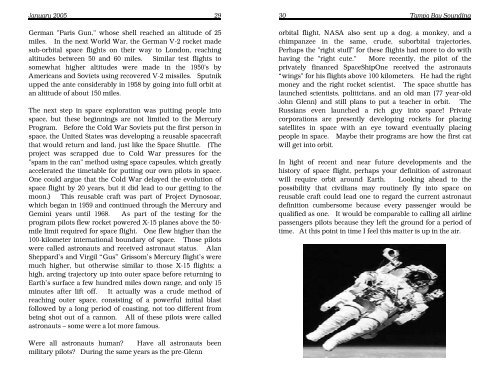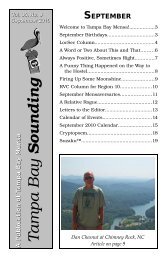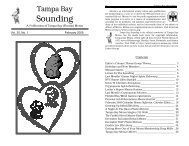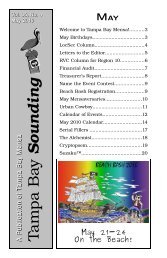Create successful ePaper yourself
Turn your PDF publications into a flip-book with our unique Google optimized e-Paper software.
<strong>January</strong> <strong>2005</strong> 29<br />
German "Paris Gun," whose shell reached an altitude of 25<br />
miles. In the next World War, the German V-2 rocket made<br />
sub-orbital space flights on their way to London, reaching<br />
altitudes between 50 and 60 miles. Similar test flights to<br />
somewhat higher altitudes were made in the 1950's by<br />
Americans and Soviets using recovered V-2 missiles. Sputnik<br />
upped the ante considerably in 1958 by going into full orbit at<br />
an altitude of about 150 miles.<br />
The next step in space exploration was putting people into<br />
space, but these beginnings are not limited to the Mercury<br />
Program. Before the Cold War Soviets put the first person in<br />
space, the United States was developing a reusable spacecraft<br />
that would return and land, just like the Space Shuttle. (The<br />
project was scrapped due to Cold War pressures for the<br />
"spam in the can" method using space capsules, which greatly<br />
accelerated the timetable for putting our own pilots in space.<br />
One could argue that the Cold War delayed the evolution of<br />
space flight by 20 years, but it did lead to our getting to the<br />
moon.) This reusable craft was part of Project Dynosoar,<br />
which began in 1959 and continued through the Mercury and<br />
Gemini years until 1968. As part of the testing for the<br />
program pilots flew rocket powered X-15 planes above the 50-<br />
mile limit required for space flight. One flew higher than the<br />
100-kilometer international boundary of space. Those pilots<br />
were called astronauts and received astronaut status. Alan<br />
Sheppard’s and Virgil “Gus” Grissom’s Mercury flight’s were<br />
much higher, but otherwise similar to those X-15 flights: a<br />
high, arcing trajectory up into outer space before returning to<br />
Earth’s surface a few hundred miles down range, and only 15<br />
minutes after lift off. It actually was a crude method of<br />
reaching outer space, consisting of a powerful initial blast<br />
followed by a long period of coasting, not too different from<br />
being shot out of a cannon. All of these pilots were called<br />
astronauts – some were a lot more famous.<br />
30 <strong>Tampa</strong> <strong>Bay</strong> Sounding<br />
orbital flight, NASA also sent up a dog, a monkey, and a<br />
chimpanzee in the same, crude, suborbital trajectories.<br />
Perhaps the "right stuff" for these flights had more to do with<br />
having the "right cute." More recently, the pilot of the<br />
privately financed SpaceShipOne received the astronauts<br />
“wings" for his flights above 100 kilometers. He had the right<br />
money and the right rocket scientist. The space shuttle has<br />
launched scientists, politicians, and an old man (77 year-old<br />
John Glenn) and still plans to put a teacher in orbit. The<br />
Russians even launched a rich guy into space! Private<br />
corporations are presently developing rockets for placing<br />
satellites in space with an eye toward eventually placing<br />
people in space. Maybe their programs are how the first cat<br />
will get into orbit.<br />
In light of recent and near future developments and the<br />
history of space flight, perhaps your definition of astronaut<br />
will require orbit around Earth. Looking ahead to the<br />
possibility that civilians may routinely fly into space on<br />
reusable craft could lead one to regard the current astronaut<br />
definition cumbersome because every passenger would be<br />
qualified as one. It would be comparable to calling all airline<br />
passengers pilots because they left the ground for a period of<br />
time. At this point in time I feel this matter is up in the air.<br />
Were all astronauts human Have all astronauts been<br />
military pilots During the same years as the pre-Glenn








